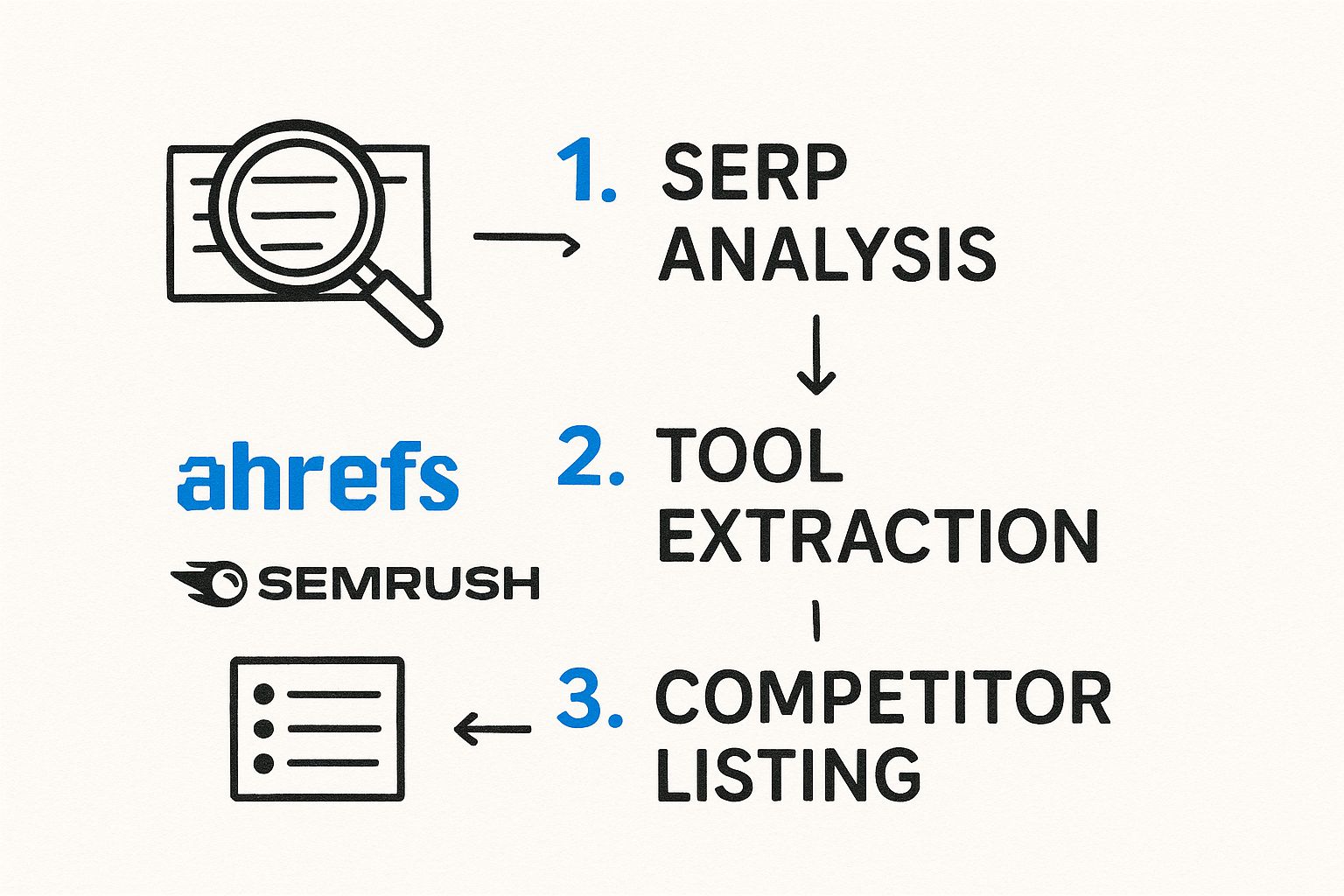Steal Competitors Keywords and Win at SEO

Maxime Dupré
10/14/2025

To find keywords your competitors are using, you just need the right SEO tool to peek at their domain. From there, you can pull a list of the keywords they rank for and cherry-pick the high-value opportunities you can target yourself.
It's not really "stealing," of course. It’s a classic competitive analysis technique that uncovers search terms already proven to work in your industry, which saves you a ton of time and guesswork. By reverse-engineering their success, you essentially get a roadmap to what your audience is searching for.
Why Analyzing Competitor Keywords Is a Smart SEO Play

Let's reframe this whole idea. While "stealing" sounds exciting, what we’re really doing is smart, data-driven market research. It’s a form of competitive intelligence, and its purpose is simple: to deeply understand the digital space you're competing in.
Think about it—your rivals have already poured time and money into figuring out which terms attract and convert customers.
Analyzing their strategy gives you a massive head start. Instead of building your entire keyword list from scratch, you get to start with a proven set of terms that are already sending traffic to a business just like yours. This isn't about blind imitation; it's about making informed decisions.
Uncover Proven Traffic Drivers
The biggest win here is that you get to skip the painful trial-and-error phase of keyword research. When you spot a competitor sitting on the first page for a keyword, that’s a huge signal that the term has value. They’ve done the hard work of validating it for you.
This lets you focus your energy on keywords with a demonstrated track record, which can seriously speed up your journey to getting meaningful traffic.
By looking at the keywords that already send traffic to your rivals, you are essentially looking at a pre-vetted list of opportunities. This isn't a shortcut—it's using available data to make smarter, faster decisions.
Find High-Value Keyword Gaps
A keyword gap analysis is where the real gold is. It shows you all the search terms your competitors rank for that you don't. These gaps often represent your biggest growth opportunities.
You might stumble upon entire topic clusters you’ve completely overlooked or find long-tail keywords with high buying intent that never came up in your own brainstorming. This process illuminates the blind spots in your content strategy and gives you a clear path for what to create next.
You can learn more about the strategic value of this approach by exploring what is competitive intelligence in our detailed guide.
How to Identify Your Real SEO Competitors
First things first: before you can even think about finding competitor keywords, you have to know who you’re actually fighting for clicks with. I see this mistake all the time—people assume their biggest business rivals are also their top SEO competitors. That's rarely the whole story.
Your main business competitor might sell the exact same thing you do, but they could be a ghost in the search results you’re targeting. At the same time, an industry blog, a niche review site, or an affiliate marketer who doesn't even have a product could be scooping up all the traffic for the phrases your customers are typing into Google.
Those are your real SEO competitors.
Go Beyond Direct Business Rivals
You need to shift your focus to the domains that pop up again and again for your most important keywords, no matter what their business model looks like. These are the sites truly battling you for your audience's attention on the search engine results page (SERP).
Let's say you sell high-end coffee makers. Sure, another coffee maker brand is a direct competitor. But your actual SEO competition is probably a much wider net:
- Content Hubs: Think big review sites like Wirecutter or Good Housekeeping that publish "best of" lists.
- Affiliate Blogs: These are the passionate home-brewing bloggers who review gear and earn a commission.
- Media Outlets: Publications like Food & Wine that feature coffee makers in holiday gift guides or product roundups.
Getting a handle on this is the first crucial step. It’s all about figuring out who you're genuinely up against in the SERPs.

This whole process is about moving from a gut feeling to a data-backed list of your true digital rivals. While targeting competitor keywords is a common strategy, how well it works can really depend on your industry.
One study I found particularly interesting showed that in the Local Services sector, there were 93 easy keywords for every one difficult keyword. That’s a massive opportunity for smaller businesses to find a foothold. If you're curious, you can dig into more of these kinds of keyword competition insights on Semrush.com.
Using Tools to Pinpoint Your True Competitors
Let's be real—manually Googling every single keyword you care about is a massive time sink. This is where dedicated SEO platforms come into play. Tools like Semrush or Ahrefs do the heavy lifting for you, instantly revealing which domains have the most overlap with your keyword set.
You can get a clear, unbiased look at the competitive landscape, often uncovering websites you never would have thought of as rivals. Nailing this step from the get-go ensures your entire keyword strategy is based on what's actually happening in the search results, not just what you assume about the market.
Uncovering Your Competitor's Keyword Strategy

Now that you have a solid list of your true SEO competitors, the real detective work begins. We’re not just compiling a long list of keywords here. The goal is to peel back the curtain and truly understand the logic behind their content—the why that drives their traffic. This is where you shift from just identifying rivals to actively learning from their wins.
Getting the raw data is usually the easy part. Most of the top-tier SEO tools like Ahrefs or Semrush have a site explorer feature. You just pop in a competitor's domain, head over to their "Organic Keywords" report, and voilà—you have a list of search terms bringing them visitors.
But that raw export is just a starting point. It's a treasure map that still needs deciphering. If you want to get the most out of this process, it helps to have a solid foundation in how to conduct keyword research like an expert.
Performing a Keyword Gap Analysis
One of the most powerful tactics for finding actionable keywords is the Keyword Gap Analysis. It’s a standard feature in most major SEO platforms, and it’s a game-changer. It directly compares your domain against one or more competitors to pinpoint the exact keywords they rank for, but you don't.
Think about it. If one competitor ranks for a keyword, that’s interesting. But if three of your biggest rivals are ranking for a term and you're nowhere in sight? That's a massive signal you simply can't ignore. This is how you discover entire topic clusters and customer pain points you might have completely overlooked.
For instance, a boutique coffee bean seller might run a gap analysis and discover their larger competitors all rank for "best coffee for french press." Maybe they never even considered targeting that term. Suddenly, that single discovery could spark a new blog post, a product bundle, or even a whole new category on their website.
A Keyword Gap Analysis isn't just about finding missing keywords. It's about identifying the strategic gaps in your content that, once filled, can capture qualified traffic and market share directly from your rivals.
This analysis hands you a prioritized roadmap for content creation. Instead of throwing darts at a board and guessing what to write next, you get a data-backed list of topics your audience is already looking for.
Decoding the Metrics That Matter
Once you have your data, you’ll be staring at a spreadsheet packed with columns and numbers. It's easy to get lost. The trick is to focus on a few key metrics that tell you 90% of the story.
To help make sense of it all, here's a breakdown of the metrics I always check first when sizing up a competitor's keyword profile.
Competitor Keyword Analysis Metrics
| Metric | What It Tells You | Why It Matters |
|---|---|---|
| Search Volume | The estimated number of monthly searches for a keyword. | It's a quick gauge of the term's popularity and overall traffic potential. |
| Keyword Difficulty (KD) | An estimate (usually 0-100) of how hard it is to rank on page one. | This helps you find the "low-hanging fruit"—valuable terms you can realistically rank for. |
| Traffic Value | The estimated monthly cost of buying that keyword's traffic via Google Ads. | A high value often signals strong commercial intent. These are the money-makers. |
| Ranking Position | Where your competitor shows up in the search results for that keyword. | Seeing what terms land them in the top 3-5 spots shows where their content is strongest. |
Looking at these data points together allows you to reverse-engineer their strategy. Are they swinging for the fences with high-volume, high-difficulty terms? Or are they quietly winning with a bunch of low-competition, long-tail keywords?
The patterns you spot will reveal their entire approach, giving you the insights you need to build a smarter, more effective strategy of your own.
How to Prioritize Keywords for Maximum Impact
https://www.youtube.com/embed/O5WyXoVl0i8
Uncovering a massive list of competitor keywords feels like a big win, but honestly, it’s just the starting line. A spreadsheet filled with thousands of terms is pure noise without a clear plan of attack. The real magic happens when you turn that raw data into an actionable content strategy that actually gets results.
Prioritization is everything. You need a system to sift through the noise and find the "low-hanging fruit"—those keywords that give you the best return on your effort right now. This comes down to striking a careful balance between three things: relevance, search volume, and ranking difficulty.
Without this filtering process, you could easily waste months chasing keywords that are way too competitive or, even worse, don't even matter to your ideal customers. Smart prioritization means every single piece of content you create has a clear purpose and a realistic shot at hitting page one.
Balancing Volume with Realistic Difficulty
It's tempting to go straight for the keywords with the highest search volume. We all see those big numbers and imagine a flood of traffic. But those "head terms" almost always come with ferocious competition from established domains you probably can't outrank today.
Instead, I always start by looking for a sweet spot. A keyword with a monthly search volume of 300 and a low difficulty score is often way more valuable than one with 10,000 searches and a sky-high difficulty. Winning these smaller, more targeted battles is how you build topical authority and gain momentum.
The fight for visibility is no joke. Organic search drives about 53% of all website traffic, and since the top five results get 70% of all the clicks, it's a brutal battle for those top spots. This is exactly why focusing on achievable keywords first is a much smarter way to gain a foothold.
Target Keyword Gaps and Content Weaknesses
Your analysis should uncover two huge opportunities that practically scream where you should focus your energy first. Spotting these will give you a serious edge.
- Keyword Gaps: These are the terms your competitors are ranking for, but you aren’t. A keyword gap analysis can reveal entire topics your audience is searching for that you've completely overlooked.
- Content Gaps: This is where your competitors have content, but it's thin, outdated, or just plain bad. It’s your golden ticket to create something ten times better and snatch their ranking.
When you focus on these gaps, you're not just creating random content. You're strategically filling holes in the market that your rivals have left wide open. This approach also helps you build out a much more comprehensive content library over time.
Don't just find what your competitors are doing; find what they are doing poorly. An outdated blog post on a competitor's site is an open invitation for you to create a superior resource and capture their traffic.
In the end, how well you prioritize keywords is measured by one thing: your ability to improve your search visibility. For anyone looking to take their strategy to the next level, there are some great resources that can help you boost keyword rankings.
This methodical approach to keyword selection is also a cornerstone of improving your overall market visibility. As you start ranking for more targeted terms, you can more effectively track and grow your brand's presence in the search results. A great next step is to check out our guide on how to calculate your share of voice in SEO to learn how to measure that progress.
Creating Content That Outranks Your Competition

Alright, you’ve done the heavy lifting. You know who you’re up against and have a solid list of high-impact keywords to target. Now for the fun part—turning all that data into content that actually wins.
Simply targeting the same keywords as your rivals won't cut it. The real goal is to create something genuinely better than what’s already sitting on page one. This is where you switch gears from being an analyst to a creator, ready to build something that truly serves the searcher.
To do that, you need to dissect the top-ranking pages to understand what Google and its users expect for any given query. It's about spotting patterns in content format, depth, and originality that you can not only meet but beat.
Deconstructing the Top-Ranking Content
Before you even think about writing, you have to become a student of the current search engine results page (SERP). Open up the top three to five results for your keyword and start digging. Ask yourself some critical questions:
- What’s the dominant content format? Are you seeing mostly long-form blog posts? Maybe it’s product pages, video tutorials, or detailed comparison tables. This is your biggest clue about what users actually want.
- How deep is the coverage? Take a close look at the subheadings and topics they cover. What are the common threads? Even more important, what are they missing? That’s your opening.
- What’s the user experience like? Pay attention to page layout, use of images, and overall readability. A clunky, text-heavy page is an easy target for a slicker, better-designed alternative.
This hands-on review gives you a qualitative blueprint for success. You’re not just trying to steal competitors keywords; you’re reverse-engineering what works to build something far more valuable.
Think of it this way: your competition has shown you the table stakes. Your job is to show up with a winning hand by creating something more comprehensive, more current, and more helpful to the reader.
The rapid rise of AI is also changing how this is done. The global SEO market was valued at $82.3 billion in 2023 and is expected to reach $143.9 billion by 2030, partly because new tools are offering much deeper insights into user intent and emerging keywords. You can discover more insights about keyword research tips for 2025 on hivedigital.com to see where this is headed.
Building Your On-Page SEO Foundation
Once you've drafted your superior content, you need to set it up for success with solid on-page SEO. This isn’t about just stuffing keywords everywhere; it’s about sending clear signals of relevance and authority to search engines.
Start by making sure your primary keyword shows up naturally in a few key places:
- Title Tag: This is still the most critical on-page element for ranking.
- Meta Description: While it doesn’t directly impact rankings, a great meta description drives clicks.
- H1 Heading: This is your main page title and should be crystal clear.
- First 100 Words: Weave your keyword into the introduction so it feels natural.
- Subheadings (H2s, H3s): Use the keyword or close variations where it fits the context.
Beyond just keywords, a smart internal linking strategy is a must. Linking to and from other relevant pages on your site helps search engines map out your topical authority and spreads link equity. A strong on-page game also complements your off-page efforts. If you want to dive deeper into that side of the equation, check out our guide on how to find backlinks on Google. This groundwork ensures your incredible new content doesn't just get published—it gets seen.
Common Questions About Competitor Keyword Analysis
Diving into a competitor's keyword strategy for the first time usually kicks up a few questions. It’s totally normal to wonder about the ethics of it all, how often you should be doing this, and what on earth to do when you feel completely outmatched.
Let's get into some of the most common things I hear and give you some straight, practical answers. This isn't just about pulling data; it's about building a smart, confident approach to SEO that you can stick with.
Is It Ethical to Steal Competitors' Keywords?
First, let's clear the air on the word "steal." It sounds dramatic, but it's not what's happening here. You aren't hacking into their analytics or taking anything away from them. Every piece of data you're looking at—their Google rankings, the content they publish—is publicly available information.
Think of it more like market research. You’re simply observing what’s working out in the open (the search results page) and learning from it. Every smart business does this. A local coffee shop checks a rival's menu and prices. A tech company analyzes a competitor's new feature launch. SEO is no different.
The goal isn't to copy-paste their content or mimic their brand voice. It's to understand the topics and search terms that matter to your shared audience, so you can go out and create something even better on your own terms.
This whole process is a standard, ethical, and frankly essential part of building an SEO strategy that’s based on data, not just guesswork.
How Often Should I Analyze Competitor Keywords?
The perfect rhythm really depends on how fast your industry moves, but letting this slip to a "once-a-year" task is a surefire way to fall behind. Things just change too quickly online.
Here’s a practical schedule that works for most businesses:
- Quarterly Deep Dive: A full, comprehensive review every three months is a solid baseline. This gives you enough time to spot major shifts in their strategy, see new content pillars they're trying to build, and measure your own progress against theirs.
- Monthly Check-in: A much quicker, high-level glance once a month is perfect for preventing surprises. You're just looking for big new keyword wins or sudden drops on their end, which could signal a Google update or a new marketing campaign they've launched.
The easiest way to make this happen? Set a recurring reminder in your calendar right now. Consistency turns this from a frantic, reactive task into a calm, proactive habit.
What If My Competitor Has Massive Domain Authority?
It can be pretty intimidating to look at a competitor with a sky-high Domain Authority (DA) and a massive backlink profile. Trying to go head-to-head with them for broad, high-volume keywords is often a losing battle, especially when you're just starting. But that doesn't mean you can't win.
You just have to play a smarter game. Forget the direct assault; it's time for surgical precision.
- Focus on Long-Tail Keywords: Go after longer, more specific search phrases. They have lower search volume, sure, but the user's intent is usually way higher. Your high-DA competitor is probably ignoring these in favor of the big trophy keywords, which leaves the door wide open for you.
- Target Their Content Gaps: Find the topics they've covered poorly. Look for articles on their site that are thin, outdated, or just barely scratch the surface. Your goal is to create the definitive resource on that topic—a "10x" piece of content that's infinitely more valuable to the reader.
- Win on User Experience: Sometimes you can win by simply being better to use. If their site is slow, clunky on mobile, or has a terrible layout, you have an edge. A faster site and more engaging content can absolutely help you outrank a stronger domain.
You don't need to beat them on every single keyword. By strategically picking your battles, you can carve out valuable pockets of traffic and build your own authority over time.
Ready to stop guessing what your competitors are doing? ChampSignal gives you high-signal alerts on their SEO, pricing, and messaging changes so you can react faster. Start your free trial and turn their moves into your opportunities.
Get Started
Competitor Monitoring That Doesn't Suck
Spend under two minutes per week monitoring your competitors. Receive only the information that matters.
Join startup founders two steps ahead of their competition.

